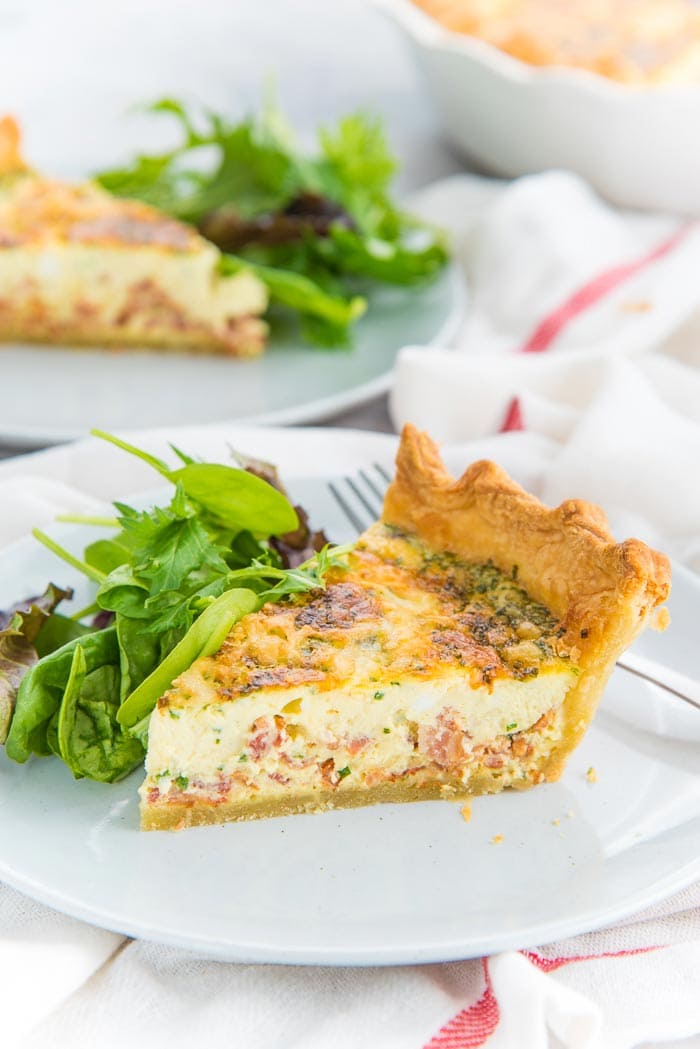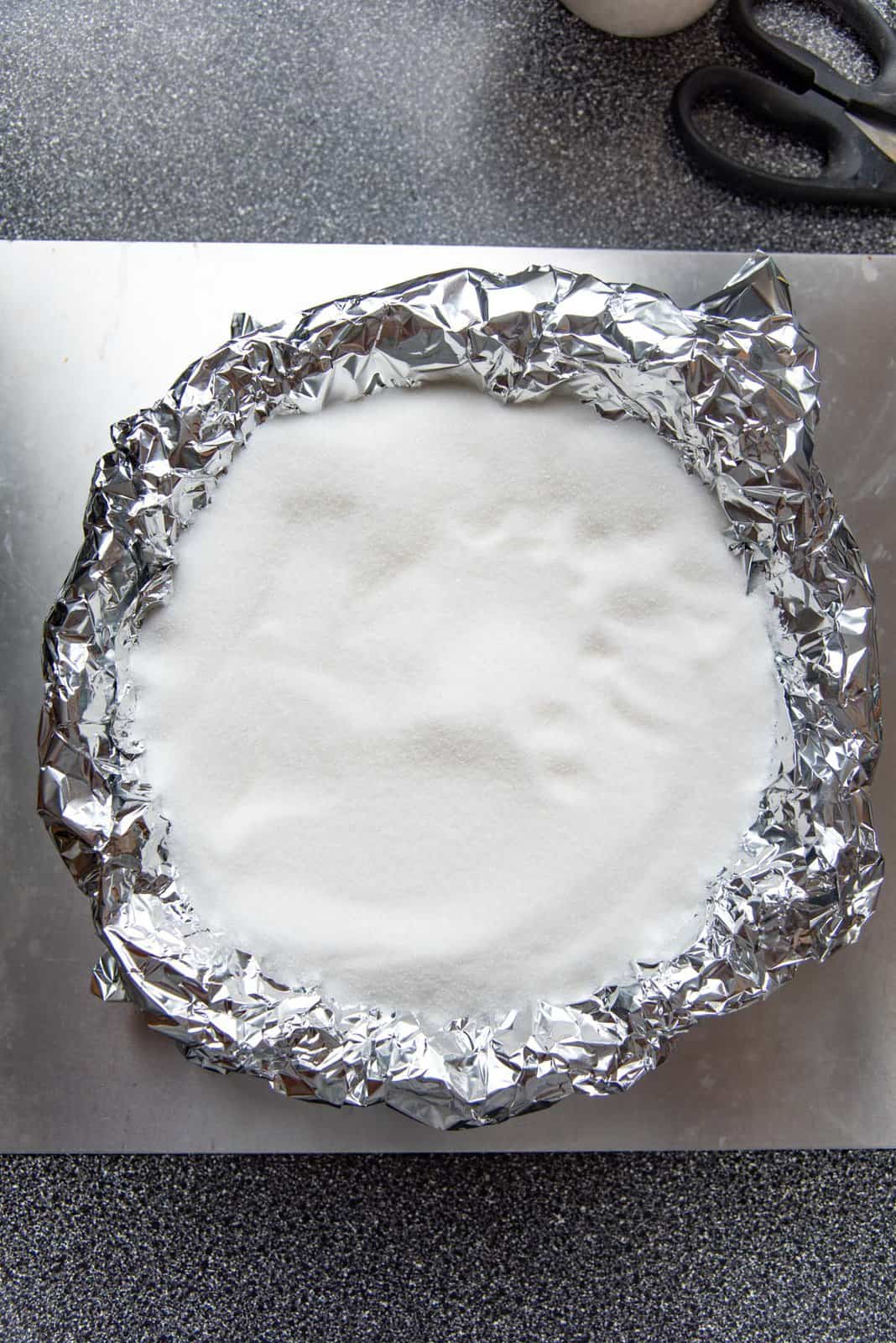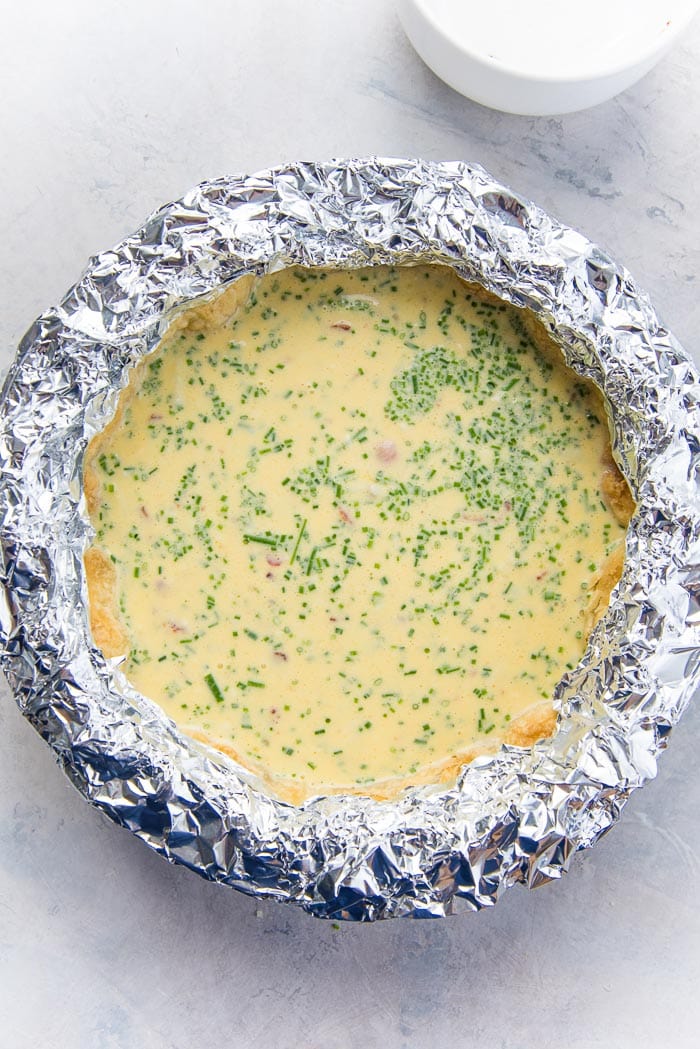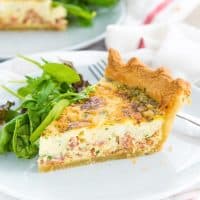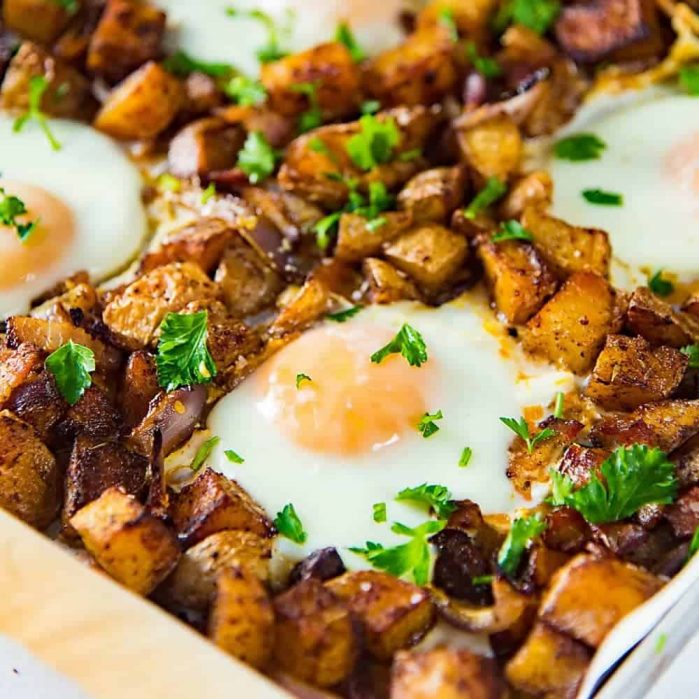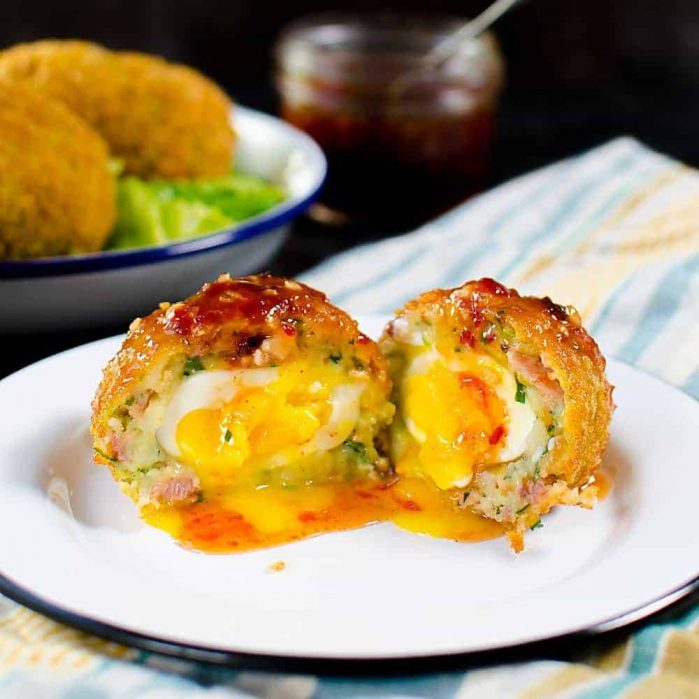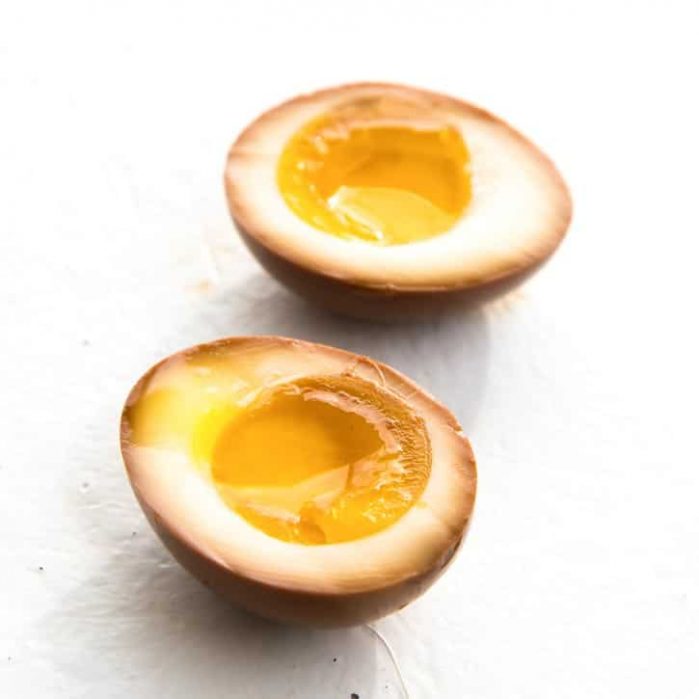This quiche lorraine is one of our favorite breakfast recipes, and it’s also perfect for brunch, lunch, or to serve a crowd. A while back, I used to work in an indie movie theater in Christchurch, NZ. This was where my affection for coffee and tea drinks was further honed and nurtured. But it was also where I ate the most perfect Classic Quiche Lorraine! There was a cafe downstairs that served slices of quiche (along with savory French toast and classic French toast), and they were nothing but creamy, cheesy, bacony, eggy indulgence.
Quiche Lorraine recipe highlights
Quiche lorraine is perfect for breakfast, brunch, lunch, or even as a light dinner with a side salad. This recipe is also great for making ahead and meal prepping. I often make it on weekends, so I can freeze the slices to eat for breakfast throughout the week. This is also perfect to serve a crowd. This quiche lorraine features my comprehensive pie crust recipe, that makes the most flaky, buttery crust. Plus, you can adapt the quiche recipe to incorporate whatever you have left in the fridge, helping you reduce food wastage. So, it’s a very versatile recipe (much like a breakfast fried rice, where you can re-purpose leftovers in an even more flavorful way!).
What is in quiche lorraine?
Here are the ingredients for the best quiche Lorraine.
Crust ingredients
All purpose flour Unsalted butter – Chilled. This helps to keep the pie crust tender, crumbly and flaky. Salt Egg yolk / egg (optional) – The purpose of eggs in this crust is to help with binding, but they are not necessary. Iced water
Filling ingredients
Eggs Cream and milk Bacon Cheese Chives or herbs Garlic (optional) Black pepper (optional)
How to make quiche Lorraine
Quiche lorraine can seem intimidating for a first-timer, but I assure you, it’s easy! A shortcrust pie crust is traditional for a quiche lorraine. This is made with butter cut into the flour to form a coarse sandy texture that creates that delicious crumbly pie crust. Water is added to bring the dough together, but the addition of egg helps to bind the dough together more easily. With my very comprehensive guide on how to make pie crust, you can make a deliciously buttery, crumbly pie crust or a flaky pie crust as well. Here I show you how to make the most perfect homemade crust, with tips on how to avoid shrinking, how to blind bake perfectly, and how to get that golden brown crust. I also share secrets on how to get a creamy, delicious and flavorful filling! The result is the perfect quiche, with the most irresistible crust and creamy filling every time!
Crust
You can make this crust in the food processor or by hand. I have done both, and while I do prefer making it by hand, the food processor is faster. Make sure the butter is cubed and chilled, OR grate the butter and freeze it. If you choose to use the egg yolk, whisk the egg yolks with ice water and keep it in the fridge until you need it (image 1). Place the flour and salt together and whisk (or pulse) to mix (image 2). Next, add the butter and toss to coat the butter pieces (image 3). If you have cubed butter, use a pastry cutter to cut the butter into smaller pieces. Or, pulse the flour and butter together to cut the butter into smaller pieces while mixing with the flour. The flour and butter should look like coarse wet sand at this stage (image 4). Add the egg yolk and water mixture to the flour and butter mixture while mixing it in (or pulsing in the food processor). Add more ice water (i.e. just enough water) to bring the dough together. However, the dough should still be on the drier side, because adding too much water can contribute to the dough shrinking when baking. The dough has enough water when the flour mixture forms a ball when you squeeze it together, but still has some dry spots (image 5). Turn the dough out onto a parchment paper and use the parchment paper to bring the dough together. Form it into a rough disc and refrigerate for about 30 minutes or more (images 6, 7 and 8). Once the dough is rested in the fridge, roll it out into a circle that is about 3 mm thick (image 9). Having a thin crust will ensure that you have a wonderfully flaky crust when the quiche is baked through. Line a 9-inch deep pie dish, or a 9.5 inch deep tart pan with the rolled out dough. Do not stretch the dough to fit the pie pan. Instead, lift and gently rest the dough in the pan along the edges to line the pan (image 10). Cut the excess dough (image 11). Leave a border if you’re using a pie dish, so that you can roll the pie crust edge to form a slightly thicker pie crust when baked (image 12). Then flute or crimp the edge if you like (image 13). With tart pans, this is not necessary, and the excess can be cut off. Refrigerate for about 1 hour or freeze for about 30 minutes while the oven is preheating.
Blind-baking the pie crust
Once the oven is preheated, line the chilled quiche crust with 1 – 2 pieces of foil. Making sure that the entire surface of the crust is covered by foil. Fill the foil liner with pie weights. I like to use sugar or rice, because the smaller grains do a better job of covering a bigger surface area. Bake the crust in the oven for about 45 – 50 minutes until the crust has started to turn darker in color. Next, remove the weights, prick the bottom of the crust, and bake in the oven for a further 5 – 10 minutes until the bottom of the crust is dried out and is just starting to color. Remove from the oven and let it cool down. You can make the crust the day before if you like, but you can also fill the crust when it’s a little warm.
Make the filling and bake
The filling is very easy to make with this classic recipe! The first step is to cut the bacon into pieces and cook it over medium heat until the bacon is a little caramelized (image 14). Drain the excess fat, and set the bacon aside. Place the eggs and cream in a bowl and whisk very well to combine (image 15). Set a little bacon aside for the top of the quiche, and add the rest of the bacon to the bowl with the eggs (image 16). Followed by the cheese and chives, and then mix with a spatula (image 17). Add a little bit of salt as well, but make sure not to add too much. The bacon and cheese will also add salt to the filling. Pour the egg mixture into the blind-baked crust. Gently stir to ensure all of the filling is evenly distributed (image 19). OPTIONAL – Dot the top of the quiche with some goat cheese or cream cheese. Sprinkle the extra bacon on top (image 20). Return the quiche to the oven and bake until the filling is baked through and the crust is golden brown (image 21). For a prettier crust, brush the crust with some egg wash, so that the crust has a beautiful golden brown sheen. If the crust is browning too fast, use a crust shield to cover the crust as it bakes. Let the quiche cool down slightly and serve while still warm.
Pro tips to make a perfect crust for your quiche lorraine
Start with chilled ingredients – All the ingredients for the crust need to be chilled before you start; butter, flour, egg, and water. This will ensure an incredibly delicious, flaky crust. Never overwork the dough – You must knead the dough to bring it together. However, I prefer to use a gentle fold-and-turn method to knead the dough. The folding action will also create buttery, flaky layers, while making sure you don’t overwork the gluten (which can cause the crust to shrink). If you use your food processor, make sure to pulse the mixture until the ingredients are just mixed through. The final step of bringing the dough together must be done by hand. REST the dough – This is so important! I let it rest in the fridge for at least 1 hour. The gluten will relax and help prevent crust shrinkage. Roll the dough freely – Make sure your work surface is lightly floured so that the dough doesn’t stick. Flip the dough, so you roll it out on both sides, while applying equal pressure, so that you roll out the dough to an even thickness. Do not stretch the dough – When placing the dough in the pie/quiche dish, make sure not to stretch the dough in the pan. If there are bubbles under the crust, or the crust hasn’t quite gotten into the edges of the pan, do not push the dough in and stretch it out. Instead, gently lift the dough, and replace it in the pan without bubbles or gaps. Dock the crust – I like to dock the crust before baking, but I also dock the crust during the blind baking process as well. This helps the crust retain its shape as it blind bakes and cools. Bake low and slow – Usually blind baking is done at a high temperature for a short time. This is still an option, but I prefer baking at 350 F for a longer time. This ensures that the crust keeps its shape, there is less shrinkage, and less chance of the crust slipping down. The filling should definitely be baked at a low temperature so that the custard filling doesn’t overbake and become dry. Use cornstarch or Instant ClearJel (modified cornstarch) – This will help to keep the filling smooth and creamy. Using cream in the filling mixture also helps to create a creamy filling.
Should I blind bake the crust or not?
I prefer to blind bake the crust. This lets the crust become crisp and turn golden brown, reducing any chances of the dough being under-cooked and stodgy. If you add the filling to the raw crust and bake it, the egg custard will keep the crust soggy and not bake through. OR if you bake the crust till it’s golden brown, the egg filling will overcook. With blind baking, my crust is ALWAYS golden and flaky on the sides and on the bottom, and not a soft, soggy mess. So, I recommend always blind baking. I used to use ceramic pie weights or dry beans, but since making hundreds of pies (check out my breakfast pie recipes and dessert pie recipes for a full archive), I have switched to using rice or sugar. Another tip to make blind baking easier is to line the pie crust with foil before placing the pie weights inside. This way you can easily remove the pie weights when the time is right, and there’s nothing sticking to the quiche crust.
How to upgrade your quiche Lorraine (my favorite additions)
You can add even more flavor to your quiche lorraine filling with these additions.
Minced onion Finely chopped spring onions Caramelized onions (my favorite addition) Chives or garlic chives (here, I’ve used chives because I love the specks of green in that creamy quiche lorraine) Minced garlic or garlic powder Thyme, rosemary or other herbs such as basil, parsley, dill Fresh chili (sliced or chopped) Goat cheese or cream cheese for some tangy creamy texture in the quiche Other types of cheese such as cheddar, mozzarella, feta, monterey jack, gruyere cheese etc.
You can also add other ingredients. But if these ingredients have a higher water content, it’s important to either remove the excess water OR add some cornstarch to help absorb that extra liquid. For example,
Sauteed mushrooms Sauteed spinach Kale or other leafy greens (sauteed to add more flavor) Sauteed or roasted vegetables Sliced potatoes or sweet potatoes Tomatoes Leeks Leftover meat – rotisserie chicken, cooked ground beef, ham Breakfast sausages
What to serve with quiche Lorraine
I prefer serving this warm, or at room temperature. I also like to keep the sides simple. A green salad with a simple vinaigrette is my idea of the perfect side dish, since this quiche Lorraine is really quite rich and flavorful. You can also serve it just as is, or even with a dollop of crème fraîche. Since I make this often for summer brunch, I usually pair this with a pitcher of my galaxy lemonade, or my ginger rose fizz drink. They are the perfect summer drinks to complement this easy quiche recipe.
Storage and make ahead tips
This quiche lorraine can be made ahead of time too! The crust can also be made the day before you need to bake the quiche. Just bake the crust and leave it in the fridge overnight. Once the filling is baked, the quiche can be stored in an airtight container in the fridge for up to 5 days. Although, it’s best served the on the day you bake it, or the next day.
Tools I use for this recipe
Silicone pastry mat – Makes it much easier to roll out the pastry, but you can use a smooth countertop as well. Rolling pin – A heavy rolling pin ensures evenly rolled out pastry dough. You can use a wooden or plastic or steel. 9 inch deep pie dish or 9 inch deep quiche pan – I like using a deep pie dish so that I can add more of the filling, plus this is so beautiful that the quiche can be served right in this dish. Pie weights – I just use raw rice or white sugar.
Commonly asked questions
More delicious brunch recipes you’ll love
Bacon and egg pie Oven roasted breakfast potato hash Cinnamon rolls Pizza egg muffins Sausage frittata Mushroom, bacon, egg breakfast pie Brioche cinnamon rolls Overnight yeasted waffles


